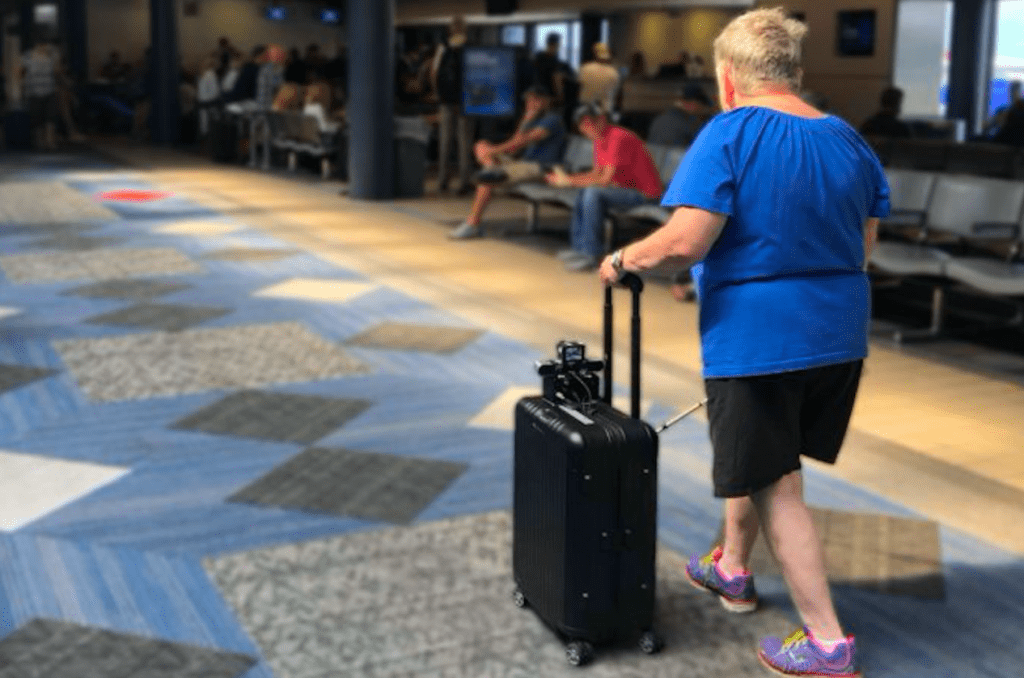PIT Trials New Solutions for Visually Impaired Travelers
Share

Pittsburgh International Airport CEO Christina Cassotis wants the facility to be accessible by everyone, so she’s leading an initiative to explore new products and services in the hopes of improving the experience of visually impaired travelers.
Pittsburgh International Airport (PIT) recently teamed up with a range of university researchers to trial two initiatives aimed at helping visually impaired travelers navigate airports more independently.
The first, a smart suitcase called BBeep, was created by researchers from the University of Tokyo and Waseda University to help blind people navigate crowded spaces. The suitcase is fitted with a camera that tracks pedestrians in the user’s path and calculates the potential of a collision.
When BBeep predicts a collision will occur in five seconds time, it begins issuing a series of beeps that increase in frequency when the collision is perceived to be 2.5 seconds away. When a collision is imminent, the suitcase issues a “stop” sound, prompting the user to halt immediately.
“Sighted people will usually clear a path if they are aware of a blind person,” said Dr. Chieko Asakawa, IBM Fellow and professor at Carnegie Mellon University’s Robotics Institute, who has been blind since she was 14. “This is not always the case, as sighted people may be looking at their smartphone, talking with others or facing another direction. That’s when collisions occur.”
Six visually impaired participants tested BBeep at PIT, maneuvering the smart case with one hand and using a white cane in the other. They were asked to walk five similar routes in three modes – one where the suitcase gave no warnings, another in which the warnings could only be heard by the user through a headset, and another in which warnings were played through a speaker so others could hear them.
The researchers said the speaker mode proved most effective both in reducing the number of pedestrians at risk of imminent collision and in reducing the number of pedestrians in the user’s path. The researchers believe the rolling suitcase itself also helps clear the way and serve as an extended sensing mechanism for the user.
However, one issue the team noticed during the trial was that in some cases, pedestrians had already noticed the visually impaired traveler and were clearly planning to move out of the way, but the beeps would begin regardless. The research team behind BBeep suggested this could be solved by introducing gaze tracking on the camera.
Researchers at @CarnegieMellon have developed an app to help vision-impaired travelers navigate airports and other indoor spaces. Read for more on how PIT served as a testing ground for NavCog and a smart suitcase called BBeep: https://t.co/lf5sC8MDa7
— Pittsburgh International Airport (@PITairport) May 7, 2019
Users also said they would like to complement BBeep with a headset that tells them what’s happening around them. The researchers commented that the solution could be paired with a turn-by-turn navigation service, prompting IBM and researchers from Carnergie Mellon University (CMU) to develop NavCog, a smartphone-based app that employs Bluetooth beacons, which was also tested at PIT.
The app has already been deployed on campuses, including CMU, and in shopping malls, but was modified for use at the airport where wide corridors make users vulnerable to veering and where there are moving walkways. As part of the project, PITt installed hundreds of Bluetooth beacons throughout their facilities.
NavCog, which is free to download, uses a map that has been annotated with the locations of restrooms, restaurants, gates, entrances and ticketing counters to give accurate audio directions to users.
Ten legally blind people tested the app using an iPhone 8 with good results, traversing the terminal’s large open spaces, escalators and moving walkways with few errors. Researchers said most users were able to reach the ticketing counter in three minutes, traverse the terminal in about six minutes, go from the gate to a restroom in a minute and go from the gate to a restaurant in about four minutes.
Another company using Bluetooth beacons to improve the passenger experience is Neatebox, whose Welcome app is currently in use at Edinburgh Airport.


